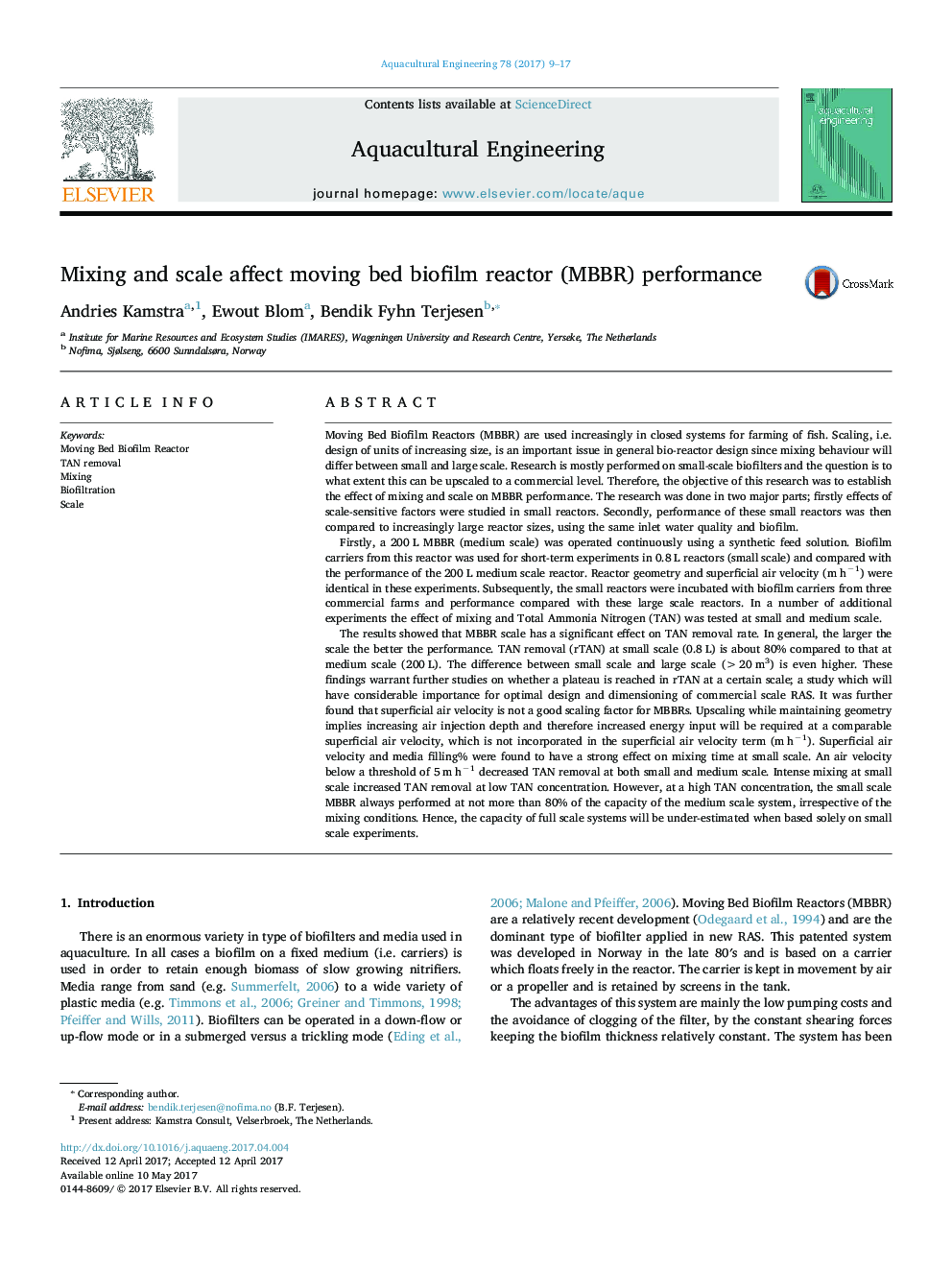| کد مقاله | کد نشریه | سال انتشار | مقاله انگلیسی | نسخه تمام متن |
|---|---|---|---|---|
| 5763919 | 1412990 | 2017 | 9 صفحه PDF | دانلود رایگان |

- Superficial air velocity and media filling% have a strong effect on mixing time of a small scale Moving Bed Biofilm Reactor (MBBR).
- TAN removal rate decreases below an air velocity of 5 m·â1 at both small and medium scale MBBR's.
- Intense mixing increases TAN removal at small scale at low TAN, at high TAN oxygen likely becomes limiting.
- TAN removal in full scale systems is significantly higher compared to that in small scale systems.
Moving Bed Biofilm Reactors (MBBR) are used increasingly in closed systems for farming of fish. Scaling, i.e. design of units of increasing size, is an important issue in general bio-reactor design since mixing behaviour will differ between small and large scale. Research is mostly performed on small-scale biofilters and the question is to what extent this can be upscaled to a commercial level. Therefore, the objective of this research was to establish the effect of mixing and scale on MBBR performance. The research was done in two major parts; firstly effects of scale-sensitive factors were studied in small reactors. Secondly, performance of these small reactors was then compared to increasingly large reactor sizes, using the same inlet water quality and biofilm.Firstly, a 200 L MBBR (medium scale) was operated continuously using a synthetic feed solution. Biofilm carriers from this reactor was used for short-term experiments in 0.8 L reactors (small scale) and compared with the performance of the 200 L medium scale reactor. Reactor geometry and superficial air velocity (m hâ1) were identical in these experiments. Subsequently, the small reactors were incubated with biofilm carriers from three commercial farms and performance compared with these large scale reactors. In a number of additional experiments the effect of mixing and Total Ammonia Nitrogen (TAN) was tested at small and medium scale.The results showed that MBBR scale has a significant effect on TAN removal rate. In general, the larger the scale the better the performance. TAN removal (rTAN) at small scale (0.8 L) is about 80% compared to that at medium scale (200 L). The difference between small scale and large scale (>20 m3) is even higher. These findings warrant further studies on whether a plateau is reached in rTAN at a certain scale; a study which will have considerable importance for optimal design and dimensioning of commercial scale RAS. It was further found that superficial air velocity is not a good scaling factor for MBBRs. Upscaling while maintaining geometry implies increasing air injection depth and therefore increased energy input will be required at a comparable superficial air velocity, which is not incorporated in the superficial air velocity term (m hâ1). Superficial air velocity and media filling% were found to have a strong effect on mixing time at small scale. An air velocity below a threshold of 5 m hâ1 decreased TAN removal at both small and medium scale. Intense mixing at small scale increased TAN removal at low TAN concentration. However, at a high TAN concentration, the small scale MBBR always performed at not more than 80% of the capacity of the medium scale system, irrespective of the mixing conditions. Hence, the capacity of full scale systems will be under-estimated when based solely on small scale experiments.
Journal: Aquacultural Engineering - Volume 78, Part A, August 2017, Pages 9-17